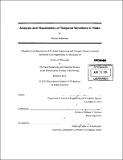| dc.contributor.advisor | William T. Freeman. | en_US |
| dc.contributor.author | Rubinstein, Michael, Ph. D. Massachusetts Institute of Technology | en_US |
| dc.contributor.other | Massachusetts Institute of Technology. Department of Electrical Engineering and Computer Science. | en_US |
| dc.date.accessioned | 2014-06-13T22:34:04Z | |
| dc.date.available | 2014-06-13T22:34:04Z | |
| dc.date.copyright | 2014 | en_US |
| dc.date.issued | 2014 | en_US |
| dc.identifier.uri | http://hdl.handle.net/1721.1/87934 | |
| dc.description | Thesis: Ph. D., Massachusetts Institute of Technology, Department of Electrical Engineering and Computer Science, 2014. | en_US |
| dc.description | Cataloged from PDF version of thesis. | en_US |
| dc.description | Includes bibliographical references (pages 113-118). | en_US |
| dc.description.abstract | Our world is constantly changing, and it is important for us to understand how our environment changes and evolves over time. A common method for capturing and communicating such changes is imagery - whether captured by consumer cameras, microscopes or satellites, images and videos provide an invaluable source of information about the time-varying nature of our world. Due to the great progress in digital photography, such images and videos are now widespread and easy to capture, yet computational models and tools for understanding and analyzing time-varying processes and trends in visual data are scarce and undeveloped. In this dissertation, we propose new computational techniques to efficiently represent, analyze and visualize both short-term and long-term temporal variation in videos and image sequences. Small-amplitude changes that are difficult or impossible to see with the naked eye, such as variation in human skin color due to blood circulation and small mechanical movements, can be extracted for further analysis, or exaggerated to become visible to an observer. Our techniques can also attenuate motions and changes to remove variation that distracts from the main temporal events of interest. The main contribution of this thesis is in advancing our knowledge on how to process spatiotemporal imagery and extract information that may not be immediately seen, so as to better understand our dynamic world through images and videos. | en_US |
| dc.description.statementofresponsibility | by Michael Rubinstein. | en_US |
| dc.format.extent | 118 pages | en_US |
| dc.language.iso | eng | en_US |
| dc.publisher | Massachusetts Institute of Technology | en_US |
| dc.rights | M.I.T. theses are protected by copyright. They may be viewed from this source for any purpose, but reproduction or distribution in any format is prohibited without written permission. See provided URL for inquiries about permission. | en_US |
| dc.rights.uri | http://dspace.mit.edu/handle/1721.1/7582 | en_US |
| dc.subject | Electrical Engineering and Computer Science. | en_US |
| dc.title | Analysis and visualization of temporal variations in video | en_US |
| dc.type | Thesis | en_US |
| dc.description.degree | Ph. D. | en_US |
| dc.contributor.department | Massachusetts Institute of Technology. Department of Electrical Engineering and Computer Science | |
| dc.identifier.oclc | 880144326 | en_US |
